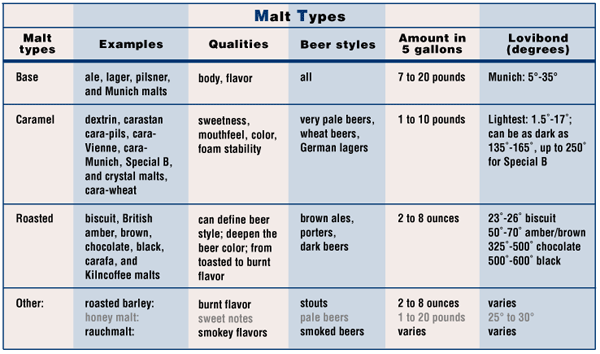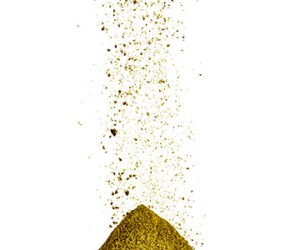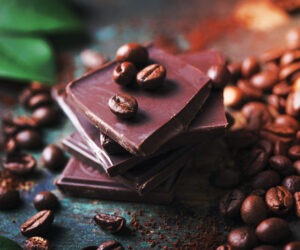Malt Madness: Specialty Grains
Ten years ago a top notch retailer’s selection of supplies probably included a couple dozen British extracts and kits, a couple of German ones, and one or two American brands; eight to 10 hop varieties; three or four dry yeasts; and five or six specialty malts.
These days things have become more interesting. The array of malt extracts in many stores includes selections from Australia and Belgium, the hop list could require a chart four feet high, there may be 25 yeast strains from which to choose, and malts sometimes require their own room with floor bins for the base malts and specialty grains two shelves high. An embarrassment of riches. Many of the specialty grains are from Belgium, Britain, and Germany. Some didn’t even exist a decade ago.
Many a brewer’s first beers were very simple concoctions built of extract syrup and some added hops, but many brewers are now taught to make better beer right from day one. Better beers require adding some specialty grains to round out and enrich the malt extract. Even for beginning brewers grains can be used alone or in concert with extract to mold a beer’s flavor and color profile and enhance its overall character. But it’s still a bad idea to send beginners into the malt room without a native guide.
In the Beginning
There are two broad categories of specialty malts: caramel malts and roasted malts. All the malts start out the same as “base malts,” which are the foundation and framing of beer. (In this analogy specialty malts are like the paint, the carpeting, and the cabinetry — they make the beer house more interesting and distinctive.)
All malt starts as raw grain, usually raw barley (exceptions will be noted below). Barley not only gives beer its special flavor, but the grain itself seems to have been designed to make the maltster’s and brewer’s jobs easier. It has all the necessary proteins, carbohydrates, and enzymes, as well as a physical structure tailor made for brewing — it even comes with its own built-in filter bed.
The grain is soaked (“steeped”) in tepid water for several days. This lightly washes the grain and allows the moisture content of the barley to rise enough for germination to begin.
Germination can take place in a number of ways. The traditional method (now very rare) was called “floor malting,” with the “green” malt spread on a specially constructed floor that allowed water to drain off. The grain was turned with hand tools to keep temperatures even and the malt well aerated. More modern methods include rotating drums or pneumatic systems, primarily the latter.
One pneumatic system, known as the Saladin Box System, is used by more then 90 percent of North American maltsters. In this system the green malt is spread out in a large compartment with a false floor. Screws regularly turn the grain and fans blow air up through the grain, maintaining consistent temperature, aerating the grain, and driving off CO2.
During germination the barley embryo begins development in the seed. Enzymes are formed, and the process is begun that will eventually provide the simple sugars necessary for fermentation. Much of the protein breakdown takes place during this period; the diastatic enzymes now being formed will only be allowed to go into action when optimum temperatures are reached in the mash tun.

Base Malts
At this stage base malts (ale malt, lager malt, pilsner malt, and so on) are “kilned.” Hot air is blown over the malt to arrest germination (by effectively killing the embryo plant) and to produce “melanoidins,” the colored aromatic compounds that give the malts their distinctive flavor and color. Depending on the nature of the beers that will be brewed from it, the malt is kilned at lower or higher temperatures. During kilning, the moisture content of the grain drops from about 45 percent to less than 5 percent, allowing the malt to be stored for long periods.
Caramel Malts
Caramel malts never get to the kiln. They are taken as green, germinating malt and placed in roasting cylinders. The heat and moisture are held at levels sufficient to effectively “mash” the interior of the malt. Starches are converted to sugars and the endosperm (the grain’s nutrient portion) is liquefied. The temperature is raised to 150° C or so, so that the sugars are caramelized (browned and hardened).
Control of time and temperature allows for a tremendous array of caramel malts. As the color increases, so does the intensity of flavor and sweetness. The darkest of the caramel malts have a definite caramel or raisin flavor, indeed. Due to the high temperatures of production, caramel malts contribute no enzymes to the mash. Because the starch conversion has already occurred, however, they can be used to good effect in extract-based beers in which there is no true mashing.
Caramel malts add to the beer’s sweetness, its mouthfeel (the perception of the beer’s body when it’s in your mouth), and its color (varying by type of malt and quantity used) and enhance foam stability (how long the head lasts after the beer is poured into a glass).
The palest caramel malts are known as dextrin or cara-pils malts. They are 1.5° to 3° Lovibond. The Lovibond scale is a commonly used system for rating the color of malt or beer. Other scales include SRM (Standard Research Method) and ASBC (American Society of Brewing Chemists). The three systems use similar methods with similar results. Knowing a malt’s Lovibond rating is crucial for accurately developing consistent recipes and targeting specific beer styles.
Low-Lovibond caramel malts are not subjected to the high temperatures that create notable darkening and sweetness. Dextrin malts are used in very pale beers to enhance mouthfeel and maltiness without adding color. Carastan malts are a British equivalent, but somewhat darker (13° to 17° Lovibond or 30° to 39° Lovibond) and slightly sweeter.
American, British, Belgian, and German malthouses all produce caramel malts in various ranges and characteristics. The “national” characteristics are not clearly definable but with practice can be discerned. Defining the differences will be the subject of a subsequent article in the series. In general it is safe to suggest that beer styles be matched with their national component (for instance British caramel malt in pale ales, German caramel in bocks).
The quality of caramel malts is determined by the quality of the raw barley and by the maltster’s skill. European caramel malts are made from the finest two-row barleys, and the Belgians seem to have the upper hand on both raw material and skill. DeWolf-Cosyns in particular produces true gems in its cara-pils (4° to 8° Lovibond), cara-Vienne (19° to 23° Lovibond) and cara-Munich (53° to 60° Lovibond) malts. Unique among caramel malts is Belgium’s Special B (75° to 250° Lovibond), an intensely rich and dark malt with a powerful, raisin-like character that adds a distinctive quality to doppelbocks and Scottish ales. Be cautious! Experiments should begin with only a few ounces in a five-gallon batch. The flavor can easily overwhelm a beer if too much is used.
American malt houses, such as Briess and Schreier, make an array of caramel malts (10° to 120° Lovibond) and the quality seems to have increased tremendously in recent years, perhaps in response to the importation of fine European malts.
British (English and Scottish) maltsters make exceptionally good caramel malts. Crystal malts range from 50° to 115° Lovibond and dark caramel from 135° to 165° Lovibond.
Special note should be made of cara-wheat (15° to 30° Lovibond), a new product from Malteries Franco-Belges. Wheat, rather than barley, is malted and caramelized, contributing its own distinctive flavor and structure.
Roasted Malts
Roasted malts are produced from regularly kilned pale malt. As the malts turn in the roasting drum, control of time and temperature produces a wide range of color and flavor.
Roasted malts have had all the enzymes and sugar made inactive (due to high heat) and are used in very small quantities to produce a specific flavor profile and deepen or darken the color of the beer. In some cases a beer style is virtually defined by the expert use of roasted malts.
The Belgians produce a very light roasted malt known as biscuit malt (23° to 26° Lovibond), which has been roasted near 160° C (320° F). When it first appeared on the American market, homebrewers seemed baffled about its use. It gets its name from the toasted flavor it adds, and has found its way into various brown ales where its nuttiness is particularly welcome. A similar malt can be produced at home by spreading pale malt on a cookie sheet and baking it at 300° F for about one hour. British amber or brown malt (50° to 70° Lovibond) has a similar biscuit-like flavor.
Chocolate malt (325° to 500° Lovibond) gets its name from the color — very like dark chocolate — not any resemblance to milkshakes. It has a very roasted flavor, like a rich coffee. Chocolate malt is particularly useful for dark ales and even stouts, less likely than its darker cousins to overburden a beer.
The darkest of all the roasted malts is black malt, sometimes known as black patent malt. At one time, apparently, the process for making this malt was patented by its originator, hence the name. Some form of black malt is produced in the United States, Belgium, Britain, and Germany. These malts are roasted at rising temperatures, 160° (320° F) to 175° C (347° F), then 215° C (389° F), and finally at 220° to 225° C (398° to 407° F), where the malt is sprinkled with water just before it can burst into flame. Black malt is one step shy of carbon and tastes like it. French or Italian roast carried to the edge.
Very little black malt (500° to 600° Lovibond) is necessary to drastically darken beer, and too much can easily ruin even the darkest stout. Variations of these malts are produced by several malt houses. In Germany the malt is known as carafa and is available in various colors. Malteries Franco-Belges makes a Kilncoffee malt, very similar in color to chocolate malt and with a distinct coffee-like aroma.
Un-Malts and Oddities
In addition to the roasted malts, there are roasted un-malts. Roasted barley is subjected to the same roasting schedule as black malt, but the barley never goes through any of the malting stages. It is somewhat harsher than black malt and is used exclusively in stouts, particularly Irish dry stouts.
Occasionally, other roasted grains (such as wheat and rye) appear, although they are unusual. Additionally, there are grains that are neither caramel malts nor roasted malts but are used for special effect in brewing. Many are produced as if they were standard base malts but with a twist.
The Canadian firm Gambrinus Malting makes something called honey malt, which is its attempt to reproduce an old German malt, Bruhmalz. Honey malt is darker (25° to 30° Lovibond) and somewhat sweeter than pale malt but without any bitterness developed through time in the roaster.
Some malts are smoked. German rauchmalt is smoked over wood. British malts intended for whiskey are smoked over peat fires. The rauchmalt is actually a base malt. It can be used for 100 percent of the grist or can be added in smaller portions for a subtler smokiness. The peat-smoked malts are definitely not intended to be used like this and should only provide a very small fraction (less than 5 percent) of the most intense beers. Over-doing it can produce a beer with a fine eau de lighter fluid character that few people find agreeable.
Munich malts (5° to 35° Lovibond) are actually base malts. Some may be floor malted, but all are kilned at slightly higher temperatures than pale malts, giving the malt a richer color, aroma, and lots of malty goodness. They can be used as base malts or as a specialty addition.
The creative and effective use of specialty malts is one of the first skills necessary to replicate beer styles or put a distinctive stamp on homebrewed beer. Whether working entirely from grains or with an extract base, specialty malts allow the brewer to determine the color, body, sweetness, head retention, and clarity of the finished beer.


